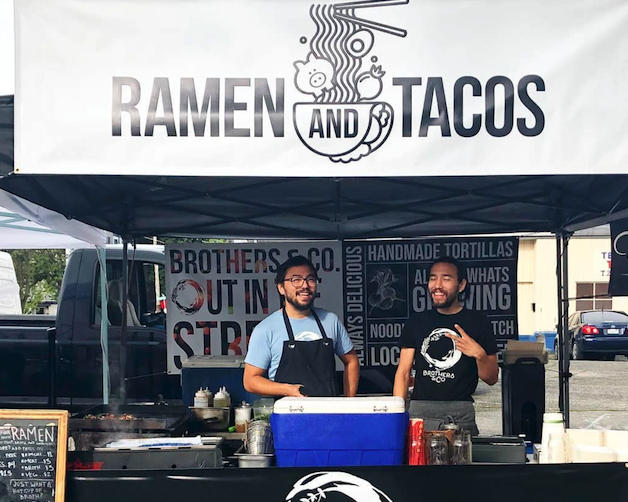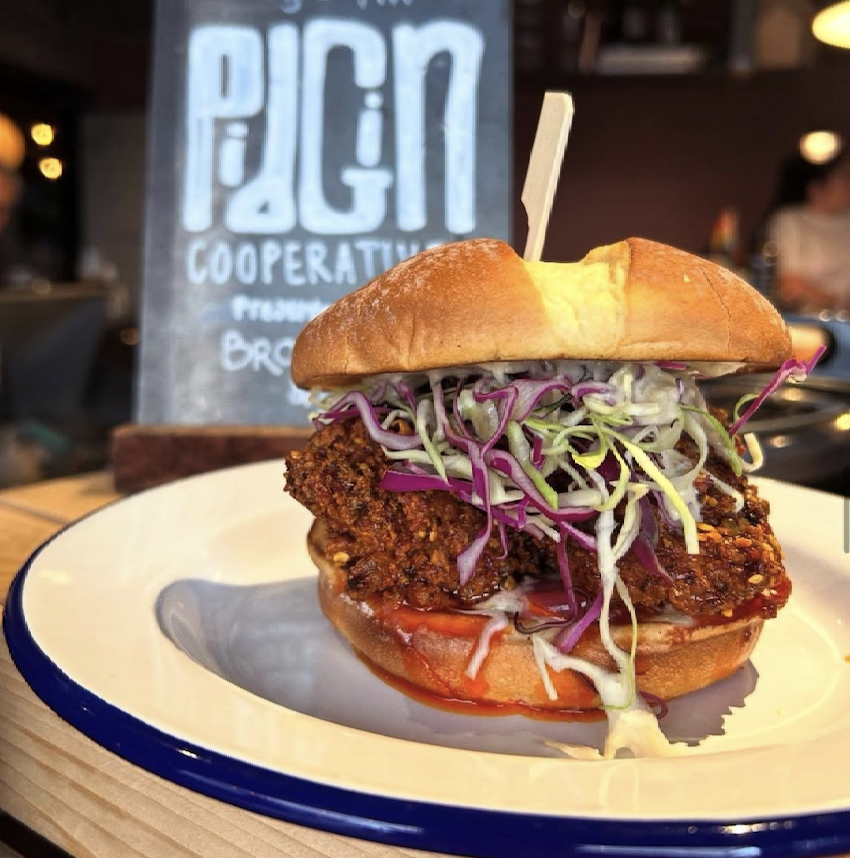🏆 Restaurant co-ops FTW
Plus: Can a Michelin star save a restaurant?
• public
A pair of Seattle brothers is rejecting traditional financing and turning their new restaurant into a co-op, giving workers a stake in the business. What does that actually look like? We break it down. Plus: Can a Michelin star really save a struggling restaurant or does it just raise the stakes? And why ketchup packets might soon be off the table in Delaware (it could cost restaurants big). Let’s dig in!

Hold the ketchup: A new bill in Delaware aims to reduce waste by prohibiting restaurants from providing single-use items like utensils, napkins and condiment packets unless customers request them. Restaurants could face fines up to $500.
Small bites, Big Pharma: As more diners take appetite-suppressing medications like Ozempic, Wegovy and Mounjaro, chefs are responding with downsized portions that deliver big flavor.
Say, what? Open-concept restaurant designs may look sleek, but they’re an acoustic nightmare. With hard surfaces and no sound-absorbing textiles, noise spills into dining areas, prompting some restaurants to rethink their layouts.
Sizzle reels: Like it or not, restaurant owners are becoming influencers. Four operator-creators share how social media shapes their careers and drives real impact at their restaurants.
Foam sweet foam? Virginia is phasing out Styrofoam food containers. A new ban went into effect July 1, starting with chains that have 20+ locations. Smaller businesses have until July 2026 to comply.


'Co-ops are historically more resilient than typical ownership models'
Brothers Zach and Seth Pacleb have been fixtures in Seattle’s food scene for years, cooking in restaurants, catering events and selling their cult-favorite ramen and tacos at farmers' markets. But when the pandemic hit, like so many in the industry, burnout caught up with them.
Their next move? A full-on reset. They’re launching their first brick-and-mortar restaurant and bottleshop, Pidgin Cooperative, and it’s not your typical setup. Instead of following the traditional model, they’re building a worker-owned cooperative where employees have a stake in the business and a say in how it’s run; a business rooted in stability and sustainability, providing long-term jobs for their members.
We talked to Zach about why this model felt right, how it’s taking shape and what it means to open a restaurant where everyone has real ownership. —Julien Perry
How did the idea for the co-op come about?
A co-op had been on Seth’s mind for a while and it seemed like a good way to address a lot of the inequities we’ve all experienced in the restaurant industry. We have also talked to other co-op owners that found that sharing the responsibilities of ownership helped alleviate burnout that Seth and I were both experiencing.
What makes a co-op different from a regular restaurant?
Functionally, Pidgin will offer the same services as a typical counter service restaurant and bottle shop. Being structured as a cooperative will allow our team to make decisions collaboratively amongst their respective departments. Also, all worker-owners have a vote on some of the bigger financial and structural decisions that the business will face. This gives them more ownership over their labor and input on their workplace conditions.
What's your biggest challenge trying to get your restaurant off the ground?
Seattle is an expensive city and none of us come from wealthy families, so access to capital to open and maintain a food business is always challenging. However, from day one, we’ve been sustained by our customers and most of our community shareholders are either long-time guests to our market stand or catering clients. We are grateful for their continued support of us in this challenging industry.
What does a co-op allow you to do as a restaurant owner that a traditional business model doesn't?
Co-ops generally are able to weather the financial ups and downs typical of small businesses. They also have lower staff turnover because of the level of intention and commitment required of its worker-owners along with the many benefits of ownership.
What's been the public reception to your upcoming restaurant? We know you surpassed your initial Kickstarter goal of $50,000.
We are glad to see so much anticipation for our restaurant from the city. Some of our market regulars are sad not to have us as a part of their weekly routine, but are excited for this next phase of the business. We are excited to be joining the Fisherman’s Terminal family and regularly have people poking their head in the door during construction to express their anticipation.
What advice do you have for someone who may be looking to open their own restaurant?
Make it a worker-owned cooperative! We need more of them in our industry and co-ops are historically more resilient than typical ownership models. This process can take a bit longer to set up, but by building a team that has vested interest in the future of the business, we can tackle these challenges together.
Above: Pidgin Cooperative's koji fried chicken sammie. (Courtesy of Pidgin Cooperative/Instagram)

Rewriting the menu on full-service dining
Restaurants are feeling the pressure to adapt to a shifting culture where guests are treating sit-down dining as a rare treat instead of a regular occasion.
Rising prices and the convenience of fast-casual means fewer appetizer and dessert orders, especially among households earning less than $100,00 a year. Inflation isn’t helping either. Menu prices jumped 4.3% year-over-year, according to a recent report from the National Restaurant Association.
Still, this isn’t the end of full-service dining; it’s actually a chance for restaurants to rethink how they offer value. Here’s what that might look like:
Improving the atmosphere with better lighting, sound and seating that’s ADA-friendly.
Focusing on hospitality, where personal touches and surprise perks can turn a one-off visit into a habit.
Refining the menu with seasonal ingredients, smaller portions and plant-based options that appeal to both the eco- and cost-conscious diner.
Upgrading tech for smoother reservations and loyalty perks—but don’t ditch the printed menu just yet. Most diners still prefer it over QR codes.
Connecting with the community through events, collaborations and live entertainment to give guests a reason to return.
More than just a meal, today’s diners want an experience and a reason to return. Restaurants that don’t adapt risk becoming a “special occasion restaurant” only.
Why it matters: The traditional restaurant model is losing ground as more consumers shift toward fast-casual options and reserve sit-down dining for rare occasions. Inflation, labor shortages and rising costs only add to the pressure. If full-service restaurants don’t roll with the changes, they risk becoming obsolete. (FRS)
The real impact a Michelin star has on a restaurant
If you’re watching Season 4 of The Bear, you know the pressure is higher than ever for the staff. (If you’re not watching, minor spoiler ahead.) The restaurant is quickly running out of money and morale is low after a lukewarm review from The Chicago Tribune. In the midst of some real talk with his team, Carmy (Jeremy Allen White) looks up and asks the question hanging in the air: “What about when we get the star?”
He’s referring, of course, to a Michelin star. It’s one of the highest honors in the culinary world, but is it a lifeline for a struggling restaurant? While the prestige can bring a surge in reservations and raise a restaurant’s profile, the reality behind the scenes is far more complicated.
For restaurants in their early days, chasing a star often means doubling down on already high costs, added pressure on staff and an unsustainable push for perfection. “You’re trying to create a balance between what’s good for business and for your vision,” says Miguel Guerra of plant-based MITA in D.C., which earned a star in its first year.
Still, the payoff can be immediate. When Olamaie in Austin received its first star in 2023, 500 reservations poured in overnight. But others, like Phillip Foss of EL Ideas in Chicago, describe the emotional rollercoaster of chasing a second star as crushing: “I was more crushed when I didn’t get two than I was elated when I got one.”
Chef Carlos Salgado of Taco María in Costa Mesa, Calif., echoes that sentiment. After earning a star in 2019, he eventually closed his acclaimed restaurant to seek relief from the “punishing intensity” that came with it.
As The Bear’s latest season suggests, maybe the real prize isn’t the star; it’s deciding whether the chase is worth it. For many, stepping back might be the healthiest move a chef can make.
Why it matters: Michelin stars drive bookings, period. But the pressure to earn (and maintain) a Michelin star can be brutal. As shows like The Bear highlight, chasing stars often means sacrificing emotional and creative sustainability. The question isn’t just “Can we get the star?”—it’s whether doing so is worth the cost. (New York Times)
5 budget-friendly marketing tips for small restaurants
You can’t stop food prices or wages from rising, but you can control your marketing spend. For small restaurants, that means getting creative. Most spend just 3–5% of their budget on marketing, so every dollar has to work harder.
Here are five strategies to make a big impact on a small budget:
1. Use a social media management tool
Tools like SocialPilot help you post consistently, schedule content and track what’s working across platforms for about $20 a month. It’s a time-saver and performance booster in one.
2. Get involved in the community
Whether it’s sponsoring a Little League team or popping up at local events, connecting with your neighborhood builds trust and visibility. Just make sure the partnership fits your brand.
3. Bring back happy hour
Happy hour is having a moment. With the right prices and portions, you can attract after-work regulars without hurting margins. MarginEdge helps calculate costs and manage inventory to keep your profits in check.
4. Celebrate the seasons
Spritzes in summer, warm soups in fall—seasonal specials give you a reason to update your menu and re-engage guests who may not have been in for a while. Tools like Meez help with real-time food costing and recipe management so you can adapt quickly.
5. Actively manage online reviews
Reviews matter, but most operators don’t have time to monitor them all. Localyser consolidates reviews from Yelp, Google, Uber Eats and more into one dashboard so you can respond fast, boosting your reputation in the process.
Why it matters: In a climate of rising food costs, labor shortages and shifting consumer habits, small restaurants face mounting pressure to do more with less. While they may lack the marketing budgets of big chains, they have one big advantage: agility. Lean into that. Be scrappy. Stay creative. And keep showing up for your guests. (Back of House)

$70.92
The average cost of feeding 10 people for the Fourth of July. (Farm Bureau)

💠 Poor parenting surcharge? It’s legal
💠 What is 'queer food'?
💠 Chefs discuss future of fine dining
💠 And the winner of ‘Yes, Chef!’ is...
💠 12 best wine restaurants in the U.S.

It takes a long time to fix a bad hiring mistake versus waiting until you find the right people—or at least someone who has a chance of evolving into the right kind of person."
– Russ Hawkins, CEO of data analytics company Agilence, on the importance of having strict criteria for hiring. (🎧 Restaurant Rockstars Podcast)
Thanks for reading today's edition! You can reach the newsletter team at editor@theprep.co. We enjoy hearing from you.
Interested in advertising? Email us at newslettersales@mvfglobal.com
Was this email forwarded to you? Sign up here to get this newsletter once a week.
The Prep is written by Julien Perry and edited by Lesley McKenzie.
